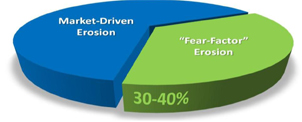Fighting margin meltdown
When Costs Are Dropping, Should Your Prices Follow?
It never fails, does it? You finally pushed those price increases through — to reflect the
fact that your input costs have been going up dramatically — and the market takes
another turn. Input costs are now speeding in the opposite direction and your customers
are expecting — or rather, demanding — price decreases.
On top of that, overall demand has softened. If you are not in a highly-differentiated space
with limited competition, you know that you will have a competitive fight on your hands.
If you do not drop your prices, you risk losing critical volume to competitors who will.
Of course, your customers probably will not switch suppliers immediately or all at once. So you might be able to “coast” for a while. While all of this is happening, your margin
percentages will look stellar. If the market condition persists and you do not make a move, you know you will lose a big chunk of everything eventually — customers, volume, and margin-dollars.
So after considering all of the options and potential impacts, you conclude that your prices are going to have to come down.
Dropping Far Enough, But No Further
The biggest challenge in dealing with price decreases in a period of softening demand and falling costs is determining just how far to go. The real “trick” is to drop prices far enough without going too far. If you can pull this off, you can protect your volumes and market share without it costing more than it is worth, or more than is really necessary.
Unfortunately, most companies have trouble pulling this off. Why?
Well, there’s a very natural explanation . . .
As human beings, it’s only natural that we’re affected by everything going on around us.
All of the doom and gloom we see and hear every day, all of the industry projections and
economic predictions — whether we like to admit it or not, it all factors into our decisionmaking.
Now, we’ve proven over and over again that even when a market is fairly stable, human beings simply have a natural tendency to overestimate buyers’ price sensitivities and underestimate their willingness to pay. Even in a stable market, these natural human tendencies result in prices that are lower than what they really should be.
Given the heightened economic uncertainty and turmoil of the current market condition, it’s easy to see how these natural human tendencies toward over-discounting can be magnified in a big way.
 As discussed previously, some level of erosion may be unavoidable in a downturn. But under these market-conditions, we’ve found that as much as 30 to 40 percent of margin-erosion is actually the result of fear-driven over-discounting — the natural human response under the circumstances.
As discussed previously, some level of erosion may be unavoidable in a downturn. But under these market-conditions, we’ve found that as much as 30 to 40 percent of margin-erosion is actually the result of fear-driven over-discounting — the natural human response under the circumstances.
Pricing Technology: Eliminating the Guesswork
So, how do you minimize the impacts of these natural human tendencies to go further than is really necessary? How do you ensure that you aren’t leaving money on the table in any market condition?
Here’s where science and technology really shine . . .
Through advanced predictive science, you can leverage your historical data to understand exactly how your customers actually respond to price. You can determine — with statistical precision — the specific attributes that result in varying degrees of price sensitivity at a transactional level. Identifying and understanding these variables is the key to knowing how far is too far when adjusting your prices.
Just to be clear, you aren’t using your historical prices to determine current or future prices. That wouldn’t make much sense in any market condition, and could be disastrous in a condition as volatile as this one. You are, however, using your historical data to determine how your customers respond to price — their price sensitivities and willingness to pay.
Of course, identifying the most relevant factors behind your customers’ price response is only part of the equation. To drive significant benefits from these understandings, you have to be able to make them operational.
To conduct the appropriate analysis and determine the appropriate pricing guidelines for every line item on every transaction manually is loaded with challenges. First, it would
When Costs Are Dropping, Should Your Prices Follow? 3
take a massive army of highly-trained pricing analysts to do all of this work. And, it would slow the sales process to a crawl — something none of us can afford to do right now.
And finally, this army of analysts would still be inclined to over discount — after all, they’re human beings aren’t they?
Software, however, can do this heavy lifting, automatically. Science-based price optimization technology can take all of the various price factors into consideration while conducting deep, rigorous analysis for every line item on every transaction. This specialized technology can instantly determine the optimal price recommendations for the specific selling situation at hand and deliver those recommendations right to the point-of-sale in real-time.
It’s a bit like having a dedicated pricing analyst for every line item and every transaction, all sitting right there while the quote is being created. But unlike human analysts, price optimization technology has no fear or emotion — it’s cold, calculating, and responsive to the facts.
Another Source of Competitive Advantage
Companies that leverage price optimization technology have a distinct advantage in economic conditions like these. By leveraging the right technology, these companies can eliminate the over-discounting in their businesses. They can protect critical volumes without giving up too much. More importantly, they can reclaim 5 to 15 percent more margin-dollars without putting any revenue at risk — sorely-needed money that would’ve otherwise slipped through their fingers.
There’s no doubt about it — the current market condition is extremely challenging. But with science and technology, you can reduce the negative impacts, minimize the guesswork, and know exactly how far is too far.
Please contact marketing@zilliant.com with questions or comments about this article.














